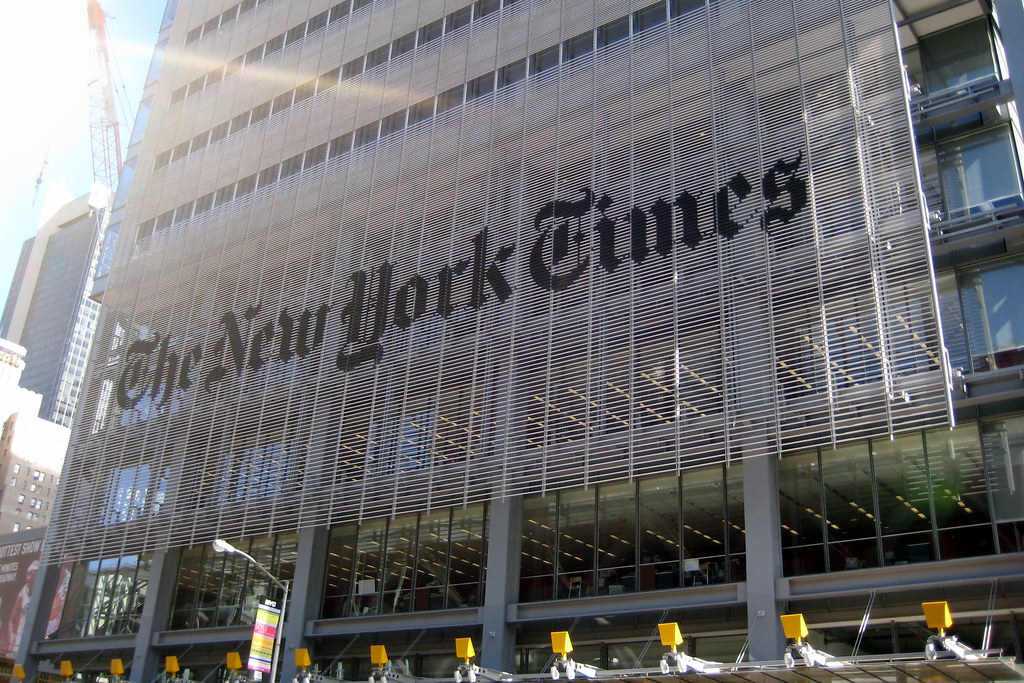The New York Times Is Unfit to Be ‘The Newspaper of Record’
Crossposted at Humanize“All the news that’s fit to print”—masthead slogan of the New York Times
Did you hear the big news? A major meta-analysis conducted by the Johns Hopkins University’s Institute of Applied Economics reviewed 24 prominent COVID-19 scientific studies and concluded both that the lockdowns of the U.S. economy prevented very few deaths while causing tremendous societal harm (pdf).
“Lockdowns during the initial phase of the COVID-19 pandemic have had devastating effects,” the authors reported.
Worse, “They have contributed to reducing economic activity, raising unemployment, reducing schooling, causing political unrest, contributing to domestic violence, and undermining liberal democracy. These costs to society must be compared to the benefits of lockdowns, which our meta-analysis has shown are marginal at best.”
Not only that, but the authors advised “lockdowns should be rejected out of hand as a pandemic policy instrument.”
Holy cow! Based on this data, we made a terrible mistake closing countless stores, shuttering restaurants, and locking the doors of service businesses. That’s a huge story worthy of prominent media reporting and discussion. At the very least, it offers a means to judge the advice given by our most prominent “expert” COVID warriors—such as Dr. Anthony Fauci and the influential bioethicist Dr. Ezekiel Emanuel, both of whom were enthusiastic lockdown boosters.
So, are you aware of the story? If you read The Epoch Times regularly or watch Fox News, you almost certainly are. Both journalistic organizations covered the news appropriately. But if your primary source for understanding current events is the New York Times, reading this column might be the first time you became aware of it, because as of this writing—nearly a week after the study was made public—the “paper of record” has not considered the study to be “news that’s fit to print.”
Why might this be? COVID has been caught up in the American culture war. When it comes to such contentious ideological and political controversies, the NY Times is not a reliable news source.
For example, the paper is bitterly opposed to all things Donald Trump. During the 2016 campaign, its media columnist even wrote that “non-opinion journalists” should “throw out the textbook of American journalism” requiring “objectivity” and “balance” to help prevent Trump from being elected. That bias continued throughout President Trump’s term in office. The paper even won a Pulitzer Prize for its story on the false Trump “Russian collusion” conspiracy theory.
The paper’s anti-Trump reporting bias extended to its COVID coverage. Indeed, even in that matter of crucial public concern, the paper seemed to adhere to one core principle: Trump is always wrong. Given that Trump opposed lockdowns early-on, covering the Johns Hopkins findings would indicate that he was right. Can’t have that!
The story also cuts against the paper’s clear propensity to believe mainstream science and medical “experts,” while denigrating heterodox scientific thinkers. In this regard, the Johns Hopkins analysis specifically validates the views expressed in The Great Barrington Declaration (GBD), a document signed by prominent physicians that decried lockdowns as causing more harm than good. Indeed, the NY Times’s reporting sought to discredit the GBD from the beginning. Can’t have that, either.
It’s not just Trump and COVID. The NY Times has long ignored stories that would cut against its cultural prejudices. This is important because much of the mainstream media follow the paper’s lead. In practice, that often means that if a story isn’t in the NY Times, it barely exists.
I have first-hand experience with the power of the NY Times to mute important stories. I was deeply involved in writing about the Terri Schiavo case as an advocate for saving her life. My opinion pieces appeared regularly in conservative media, mostly The Weekly Standard and National Review.
But it was frustratingly difficult to gain traction for the story nationally, because the NY Times never bothered to report it—until it did with a very biased news hook. When the Florida legislature passed a law designed to save Terri’s life, Operation Rescue’s controversial leader Randall Terry stood alongside Terri’s family at a news conference. That the NY Times reported on its front page—using Terry’s presence to miscast the vote as a decision “that emboldens the religious right.”
And with the snap of the Grey Lady’s fingers, the Schiavo case was transformed from a story about a desperate family trying to save the life of their beloved Terri into a bitter front in the nation’s culture war. That gave the rest of the media their marching orders. From then on, most mainstream outlets treated the Terri Schiavo case in the same biased way they do abortion stories.
Does the NY Times’s silence on the Johns Hopkins findings mean the paper will never report the story? Perhaps. The NY Times can’t be shamed into covering stories it prefers to ignore.
More likely—if its methodological history holds true—as in the Schiavo story, the editors will get around to mentioning the study in a context that allows it to discredit or mitigate its conclusions, or at a time when it has become such old news that it’s unlikely to damage the reputations of establishment scientists or boost the reputation of Trump.
Look, I’m not saying that the NY Times is the CNN of newspapers. Even I won’t go that far. The paper employs some excellent journalists and often reports important, high-quality stories.
But I do believe that in its present ideological iteration, it’s unworthy to be considered “the newspaper of record.” Its biases are too pronounced and its agendas too partisan. Perhaps the time has come for the paper to change its masthead motto to reflect its true approach to journalism: “All the news that we see fit to print.”
